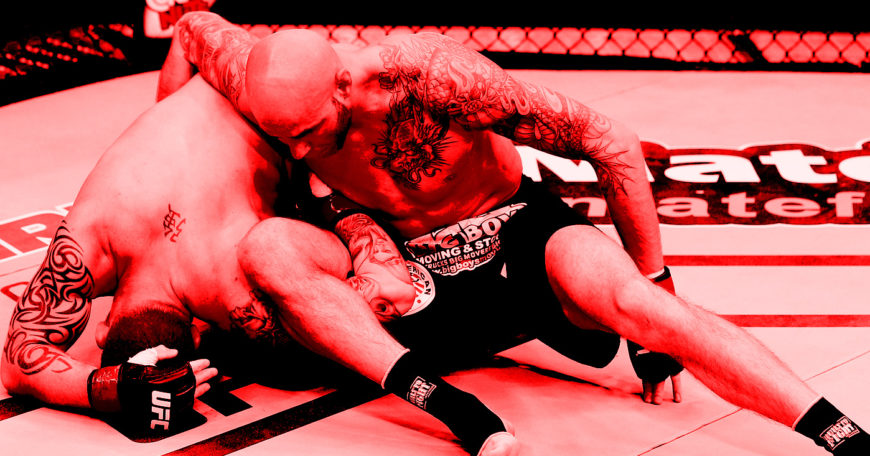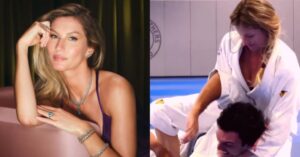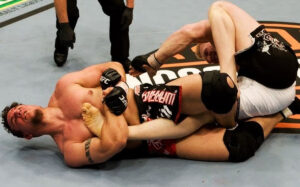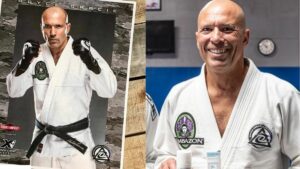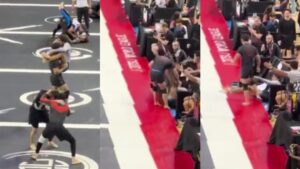The omoplata is a fundamental jiu-jitsu submission that looks flashy, but will become relatively simple with time and practice. While the mechanics of this submission lead some BJJ athletes to claim that the omoplata is low-percentage, elite athletes like Clark Gracie have proven that it can actually be an effective technique at even the highest levels of competition.
In fact, even if you struggle to tap out your opponents with an omoplata, this versatile technique can also be used as a sweep to help you gain the top position in a jiu-jitsu match.
If you’re ready to make the omoplata a part of your BJJ game plan, here’s some important information you should know.
What is an omoplata?
The omoplata is a shoulder lock that allows you to use a large percentage of your body to control a small percentage of your opponent’s body — namely, the arm that you’re attacking. The submission mechanics are similar to that of the kimura lock, with the hand of the trapped arm facing backward.
The omoplata can also be turned into an omoplata sweep, with the opponent rolling forward through the submission and ending up on their back. It can be done in gi or no-gi, but like many other submissions, it’s easier to prevent an escape when there’s gi-on-gi friction to hold your opponent in place.
How to transition to an omoplata
Closed guard is perhaps the most popular position used to set up an omoplata.
Grab your opponent’s wrist and pull it across the same side of your body. Ideally, their arm will be extended as far away from their own body as possible. Angle your body so that your head is on the same side as their trapped hand, and bring your same-side knee up onto their shoulder to push it down. At the same time, bring their forearm backward so that their palm faces the ceiling. Move your entire leg over their trapped arm, rotating yourself until you and your opponent are facing the same direction. From there, you’ll be ready to work on finishing the submission.
Failed triangle chokes often provide an easy setup for omoplatas as well. As your opponent bends their trapped arm away and grabs the inside of their thigh to prevent the choke, they leave you a perfect opportunity to apply the same transition from closed guard — they’ve already put their arm in place for you.
Spider guard is also a popular setup for omoplatas, with the extended arm (the arm that doesn’t have your foot pushing into the bicep) already being isolated from the rest of the body. All you need to do is pull it farther across your body to set up the perfect angle for the rest of the submission.
Watch the video:
Finishing the omoplata
After you’ve transitioned to the basic omoplata position and are facing the same direction as your opponent, bring your feet together with your toes pointing toward your opponent’s head, keeping your knees pinched together. This will help to keep the arm trapped as you refine your position to keep your opponent from escaping the submission.
With your nearside arm, reach across their body and secure a hold on their hip, which will provide you with a little extra control of their lower half. Scoot away from your opponent while keeping the arm trapped to help flatten them out, which will remove their base and stop them from getting the leverage they need to roll out of danger.
Once your opponent is trapped, bring your legs in front of you and angle your knees in the other direction so that your toes are pointing away from your opponent. Then, slowly lean across your opponent’s body as if to whisper a secret into their far-side ear. If you’ve gotten all the details right, this should be all you need to get the tap.
[GIF] Ben Saunders finishes the first omoplata in ufc history. Is the rubber guard viable for mma? Idk… *look into it*
by u/Mac2663 in bjj
Common omoplata mistakes
One of the perks of the omoplata is that all is not lost if you don’t get the tap. Your opponent may decide to roll over their trapped shoulder, which often puts them on their back and offers an almost instant transition to side control for you. In fact, many jiu-jitsu athletes threaten the omoplata specifically to get the sweep, which is relatively low-effort compared to other, more exerting sweeps.
Still, if you miss any crucial details, both the submission and the sweep may be lost. Some of the most common mistakes BJJ students make when going for the omoplata include:
- Staying too close to their opponent. After you’ve secured the arm, sitting up too close to your opponent can make it easier for them to control the position and take advantage of tiny amounts of space to slip their arm out or roll out of danger. Butt-scooting away from them puts the control back into your hands (or legs rather) and forces them down to the mat unless they want a broken shoulder.
- Forgetting to push down on the shoulder. Pinching your opponent’s shoulder with your knee makes it significantly harder for them to pull their arm out or stand up to escape the submission. If you skip this step, you remove the pressure that keeps your opponent’s arm in place while you make the tiny adjustments needed to secure the submission.
- Keeping your toes pointed toward your opponent’s head. Angling your legs away from your opponent provides better leverage and pressure, but it also keeps your feet safe from footlocks. Your opponent may try to use their free hand to try to submit you with a toehold if you’re not careful, so switch your leg position once their arm is trapped.
There are a lot of important details involved in the omoplata, but they’re all crucial to getting the submission (or sweep) that you’re aiming for.
Showing Off Your Shoulder Locks
Omoplatas requires attention to detail and certainly look like a long, complicated submission, but once you understand how they work and why they’ll become a valuable asset to your game.
Even if the submission doesn’t happen, you can still switch up the roll by turning it into a sweep instead. You don’t have to become the next Clark Gracie to appreciate how omoplata’s can help you defeat strong opponents without using up a lot of your own strength.

